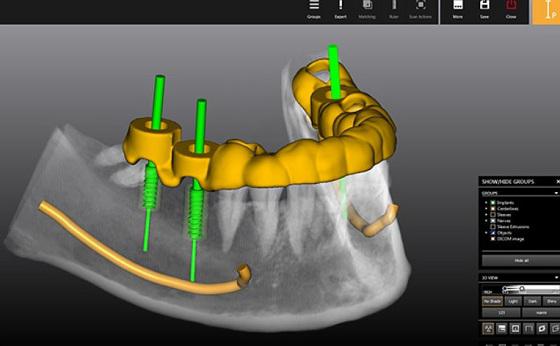I Place Implants, and I Outsource My CBCTs. Would I See Higher Acceptance If I Absorbed the Initial CBCT Cost?

For most dental implant cases, one of the first steps is to perform an initial CBCT scan. For those offices that do not have a CBCT in their office, this scan has a direct cost. Depending on where the patient is scanned, the scanning facility may charge as little as $150 or as much as $300. Charges for radiologist reviews may increase this charge further.
To cover this cost, most offices simply have the patient arrange the scan with the scanning facility, which the patient pays for directly out of pocket. In many cases, they may tell the patient this cost will be “included” if they decide to move forward with the implant treatment. This is a reasonable way to make sure the cost is covered. Furthermore, many doctors see it as a valuable indicator to determine how committed the patient is to the treatment.
However, some offices take the perspective that this initial CBCT payment may be serving as a hurdle that prevents many patients from even considering the procedure. These offices take a different approach, and remove this barrier by agreeing to absorb this cost – independent of whether the patient decides to move forward with the full treatment plan.
With all the dental offices that utilized our digital imaging solutions, we have found that the latter approach is less common. However, if done well, we have seen it be very effective in bringing implant treatment to more patients than would consider it otherwise. One of the biggest benefits of this approach is that the CBCT arms the dental professional with a really powerful graphic to make the case to the patient how the treatment plan will improve their life. These dental professionals prefer to remove barriers because once they have the cone beam scan, the patients can see the value for themselves.
However, this approach does come with risk. It would be foolish and irresponsible to encourage patients to have CT scans performed when they will not accept the treatment. So how is an office to decide the right strategy?
For those that are considering taking this approach, our recommendation is to run an experiment.
As with any good experiment, it’s important to test the variable you are focused on and keep all other variables the same. In this case, if you pick a reasonable time period — perhaps 3 months — then simply compare case acceptance during this period when patients are told that the initial scan is no charge to the acceptance rate when patient is told they will play for their scans.
Once this data is captured, it’s simple math. The key datapoint is to evaluate how many more cases get accepted – and whether this additional income pays for the added costs of paying for scans on patients that do not move forward. In this case, we will assume that in the standard operating procedure, the true cost does not change for patients that move forward with treatment – because in those cases the costs were absorbed in the broader treatment price.
Here’s an example. Let’s say that under normal operation (patient pays for their initial scan), the acceptance rate is 60%. Let’s say that for this office that does implants, but not an enormous volume, they traditionally did 3 per month.
They then perform an experiment for 3 months, in which they offer to absorb the initial scan. Let’s say that at the end of the three months, they find that they had 11 cases move forward on 15 recommendations, or an acceptance of 72%.
An increased acceptance is a good thing, but is this approach worthwhile? We can’t be sure until we compare income vs. costs.
Let’s assume the cost of that initial scan is $300 and the incremental income for the implant case is $2000. If we typically present the treatment to 15 patients in every 3 month period, then according to our experiment, changing our approach would result in about two additional cases every three months. This means that:
Additional Cost:
Scans paid for patients that do not pursue treatment: 4
Cost per scan: $300
Total Additional Cost: $1200
Additional Income:
Additional Cases: 2
Income per case: $2000
Total Additional Income: $4000
In this example, (assuming no other factors), it would be worth changing the policy to not charge the patients for that initial scan.
Of course, as with any calculation, the analysis is only as good as the inputs. In addition, it should never be done in a vacuum without considering other soft factors. For instance, perhaps there are other indicators that experience of the staff influence decisions about probability for case acceptance. However, hopefully this provides on frameworks to decide if this approach makes sense for your practice.
Learn more about Imaging Solutions from ImageWorks
Subscribe to Receive More Great Articles
